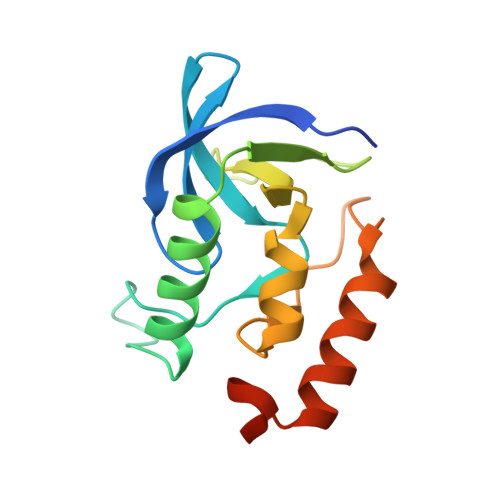The pK(a) values of acidic and basic residues buried at the same internal location in a protein are governed by different factors.
Harms, M.J., Castaneda, C.A., Schlessman, J.L., Sue, G.R., Isom, D.G., Cannon, B.R., Garcia-Moreno, E.B.(2009) J Mol Biol 389: 34-47
- PubMed: 19324049
- DOI: https://doi.org/10.1016/j.jmb.2009.03.039
- Primary Citation of Related Structures:
3D6C - PubMed Abstract:
The pK(a) values of internal ionizable groups are usually very different from the normal pK(a) values of ionizable groups in water. To examine the molecular determinants of pK(a) values of internal groups, we compared the properties of Lys, Asp, and Glu at internal position 38 in staphylococcal nuclease. Lys38 titrates with a normal or elevated pK(a), whereas Asp38 and Glu38 titrate with elevated pK(a) values of 7.0 and 7.2, respectively. In the structure of the L38K variant, the buried amino group of the Lys38 side chain makes an ion pair with Glu122, whereas in the structure of the L38E variant, the buried carboxyl group of Glu38 interacts with two backbone amides and has several nearby carboxyl oxygen atoms. Previously, we showed that the pK(a) of Lys38 is normal owing to structural reorganization and water penetration concomitant with ionization of the Lys side chain. In contrast, the pK(a) values of Asp38 and Glu38 are perturbed significantly owing to an imbalance between favorable polar interactions and unfavorable contributions from dehydration and from Coulomb interactions with surface carboxylic groups. Their ionization is also coupled to subtle structural reorganization. These results illustrate the complex interplay between local polarity, Coulomb interactions, and structural reorganization as determinants of pK(a) values of internal groups in proteins. This study suggests that improvements to computational methods for pK(a) calculations will require explicit treatment of the conformational reorganization that can occur when internal groups ionize.
Organizational Affiliation:
Department of Biophysics, Johns Hopkins University, Baltimore, MD 21218, USA.
















